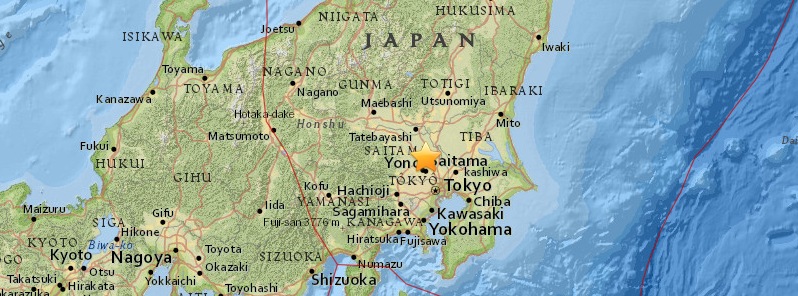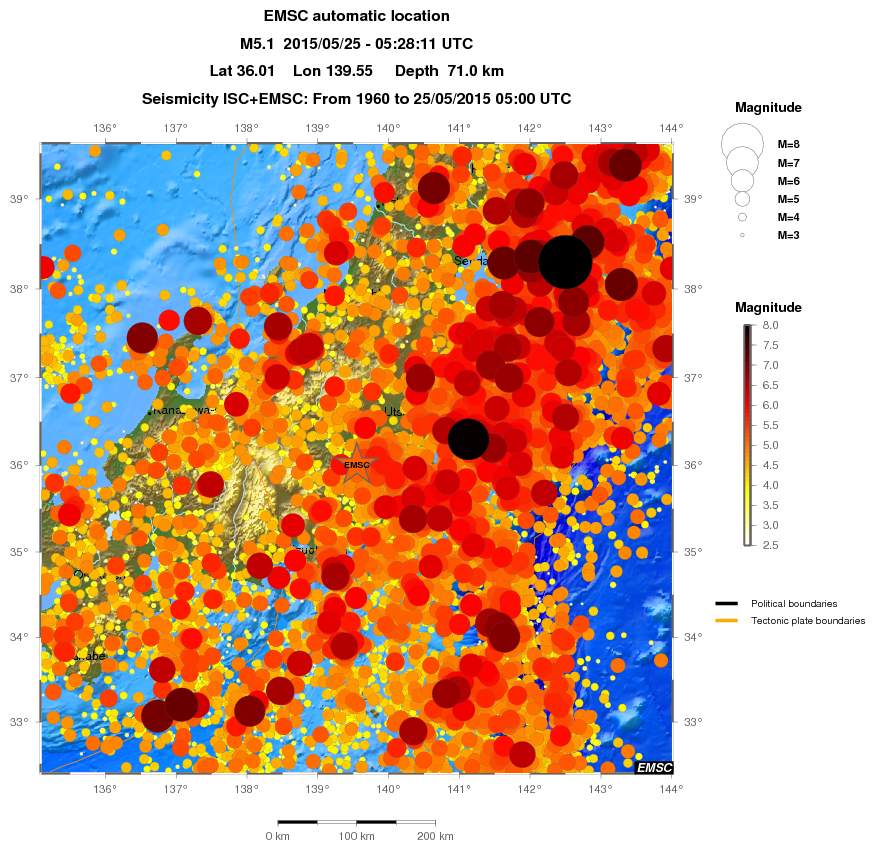M5.6 earthquake rattles Tokyo, Japan

Japan Meteorological Agency (JMA) recorded M5.6 earthquake at a depth of 50 km (31 miles) near Tokyo, Japan at 05:28 UTC on May 25, 2015. USGS reports it as M5.3 at a depth of 35.0 km (21.7 miles). EMSC reports M5.1 at a depth of 71 km (44 miles).
According to the USGS, epicenter was located 2 km (1 miles) NNW of Hasuda, 3 km (2 miles) SW of Shiraoka, 5 km (3 miles) ENE of Ageo, 7 km (4 miles) NW of Iwatsuki and 34 km (21 miles) N of capital Tokyo (population: 13.3 million), Japan.
The quake measured a lower 5 (of 7) on Japan's earthquake intensity scale in southern Ibaraki prefecture, northeast of Tokyo. It set off alarms and halted the Tokyo's subway system. Narita International Airport temporarily closed its two runways following the quake.
According to NHK, there was no danger of a tsunami, no initial reports of any damage and no reports of irregularities at the Tokaimura nuclear plant in southern Ibaraki.

Seismotectonics of Japan and Vicinity
Japan and the surrounding islands straddle four major tectonic plates: Pacific plate; North America plate; Eurasia plate; and Philippine Sea plate. The Pacific plate is subducted into the mantle, beneath Hokkaido and northern Honshu, along the eastern margin of the Okhotsk microplate, a proposed subdivision of the North America plate. Farther south, the Pacific plate is subducted beneath volcanic islands along the eastern margin of the Philippine Sea plate. This 2,200 km-long zone of subduction of the Pacific plate is responsible for the creation of the deep offshore Ogasawara and Japan trenches as well as parallel chains of islands and volcanoes, typical of Circumpacific island arcs. Similarly, the Philippine Sea plate is itself subducting under the Eurasia plate along a zone, extending from Taiwan to southern Honshu that comprises the Ryukyu Islands and the Nansei-Shoto trench.
Subduction zones at the Japanese island arcs are geologically complex and produce numerous earthquakes from multiple sources. Deformation of the overriding plates generates shallow crustal earthquakes, whereas slip at the interface of the plates generates interplate earthquakes that extend from near the base of the trench to depths of 40 to 60 km. At greater depths, Japanese arc earthquakes occur within the subducting Pacific and Philippine Sea plates and can reach depths of nearly 700 km. Since 1900, three great earthquakes occurred off Japan and three north of Hokkaido. They are the M8.4 1933 Sanriku-oki earthquake, the M8.3 2003 Tokachi-oki earthquake, the M9.0 2011 Tohoku earthquake, the M8.4 1958 Etorofu earthquake, the M8.5 1963 Kuril earthquake, and the M8.3 1994 Shikotan earthquake. (USGS) More information on regional seismicity and tectonics
Featured image credit: USGS

Commenting rules and guidelines
We value the thoughts and opinions of our readers and welcome healthy discussions on our website. In order to maintain a respectful and positive community, we ask that all commenters follow these rules.